Greetings,
This is the last post in the six-post mental backlog I had going on – and it’s definitely going to be the largest. After that, what comes next? Who knows! Actually I already know, but I digress, after this post I’ll consider Dinosaur Bear to have been caught up – just so I can get behind again. 🙂
Anyways, enough bloggerly stuff. Last time around I had discussed the start of our life in Iceland. Aside from a brief puffin adventure our lives had mostly been confined to Reykjavík, since we uh, ya know, have no car. However, if there is one thing SB and I don’t like it’s sitting around in one place for too long. So while city adventures are great (and we still have lots we want to do in the city) we wanted to try to get out into the countryside before winter comes, which is early here, as if that is any surprise.
We’ve already decided on several things we want to do, which range in difficulty (and expense) quite a bit. Since logistics are awesome we’re also trying to figure out the best order in which to do these things and even which things can be combined into a single trip. One area we decided early on that we wanted to visit was the Westfjords (Vestfirðir) – and it turns out that that part of the country is just kind of difficult to include in other trips due to geography and time (read: money) constraints. So, rather than half-ass it during another trip, or even worse, cut it out all together – we decided to make the Westfjords our first “outside-the-city” adventure.
If you’re not familiar with Iceland (and why would you be outside of those 10,000 photos/selfies of the same three spots you see posted on Instagram?) you might be wondering where the Westfjords are. Well, “West” gives away part of the answer, but like most things in Iceland it’s not that simple. In our case we actually have to go north to get to the west fjords. Here’s a handy dandy map for reference. You can see Reykjavík clearly starred down there in the southwest of the island. Then that big area up in the northwest that I’ve placed a giant black circle around? Yep, those are the Westfjords!
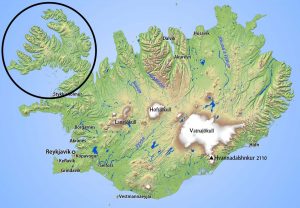
What’s in the Westfjords? Well, fjords, and a few small towns (and one “large” town of about 2,600 people), waterfalls, mountains, 1 trillion sheep, geothermal vents, etc. – you know, just normal Icelandic stuff. Now, I realize that that map has no scale on it but you don’t really need a scale to realize that we mostly definitely weren’t getting up to the Westfjords without a car. So a few weeks before SB and I were going to depart we started looking into rental cars. We found a company that was a lot cheaper than the others and went with them. After booking the car I found literally hundreds of horror stories about this company, but thankfully our vehicle turned out to be just fine. So this isn’t going to turn into some Hatchet story about us getting lost in a fjord and me killing and eating SB. In fact the only issue was that they were late providing me with the car and they were late picking up the car from their own office – yeah, tell me about it.
Anyways, now that you know I didn’t die off the in boondocks of Iceland and that the past several posts weren’t automated HAL 9000 blog-self-awareness stuff, we can resume the story.
We’d decided to make a Thursday – Sunday trip of it, which was about the minimum amount of time recommended, but really that’s all we had to work with time-wise. SB was at work during the only time we could pick up the car so I skipped class (true shocker, I know /sarcasm) to walk over to the car rental place. Turns out it’s just up the street from the immigration office, and that location is seared into my brain for all eternity. It’s about a 20 minute walk without wind, which is to say it’s never a 20 minute walk, and more like a 25 minute walk. The good news is that we were having a rare day filled with sunshine!
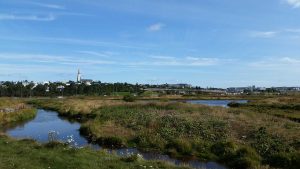
As mentioned my car was late, but fortunately there were no issues with the car itself. We decided to name the car Sue! Sue was a boy. Yes that is the reference. After I got Sue home and some stuff packed up SB got off of work and we were on our way!
Here is the start of our road trip adventure, we were on the outskirts of Reykjavík and had just passed through LIKE 400 ROUNDABOUTS.

A bit outside of Reykjavík (going north) you come to Hvalfjörður – where you have two options. Drive around the whole thing, or pay 1000 ISK and go under it via the Hvalfjörður Tunnel which is 5,770 meters (18,930 ft) long and reaches a depth of 165 meters (541 ft) below sea level. On the way up we opted for the tunnel for time purposes.
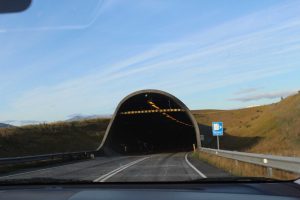
Here’s shortly after we’ve come up on the other side.
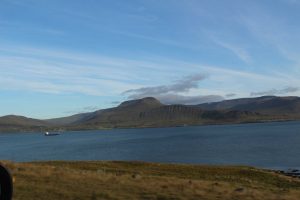
And then as we started to make our way northward from the fjord.
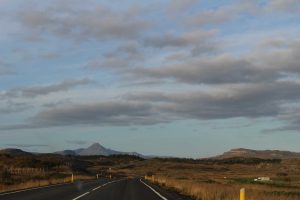
Eventually we found ourselves in a massive lava field, complete with a teeny-tiny town right in the middle of it.
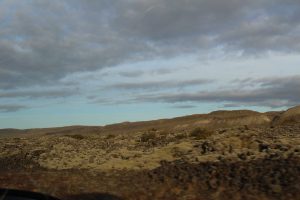
At this point in the trip we were still in “mainland” Iceland, so after we moved away from the direct coastline it was more “rolling” hills as opposed to sheer mountains.
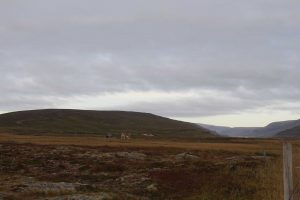
Needless to say there isn’t much out there. It’s mostly just a few dotted farmhouses (though we’d later learn that this was actually a “populated” area in comparison to what we would see).
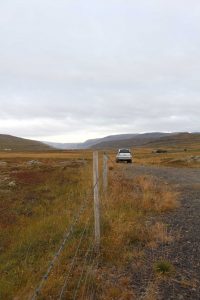
For awhile I thought we were going to get into a storm, but we either avoided it or its bark was worse than it’s bite.

Eventually we made our way off the “main” road and onto the road that would take us more directly north into the Westfjords. The geological change was pretty immediate.
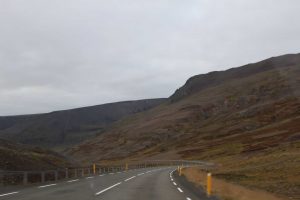
Since we hadn’t gotten started until later in the afternoon due to our schedules we weren’t planning on actually getting into the Westfjords that first night, instead we had gotten a hotel just immediately to the south (Hotel Ljósaland). Here was our view from the parking lot.
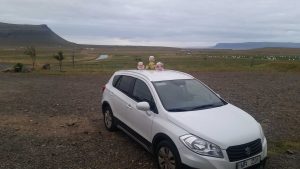
As you can see it wasn’t a hopping place. We were at the very end of the season (something we’ve done before) and as such we were literally the only people at the hotel. Like, the next day the owners/staff weren’t even there. So that was kind of interesting. But it was nice and quiet and we got the entire common room to ourselves as a result! 🙂
The next day was to be our longest driving day, so we got to bed at a decent time and then got up and on our way early the next morning. Here you can see us getting ready to cross the land-bridge over into the Westfjords.
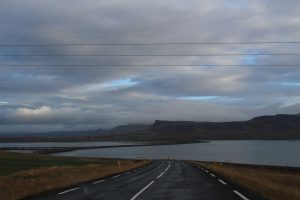
Shortly after you get into the Westfjords (going north) you are presented with the option of going left or right. To the left are small (read: very small) towns, gravel roads, dirt roads, roads that really aren’t roads, HUGE fjords, and 100 billion sheep. To the right is an actual road, one less-small town, a few smaller towns, big fjords, and 100 billion sheep. Since we were circumnavigating a good chunk of the Westfjords we took a turn to the left. Shortly after that the road turned into this.
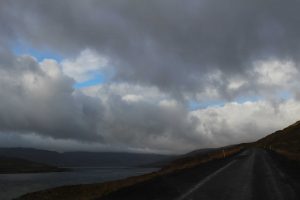
Sue got oh so very muddy, but fortunately Sue was an AWD so Sue didn’t give no shits. By and large this area of the road was still in pretty good shape, it was just very windy and curvy in a few areas.
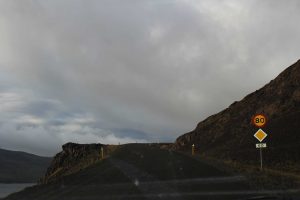
The nice thing about that route was that were was hardly anyone else on it, so it was mostly just us and the wilderness.

Every so often they have little pull-off/camping areas, which range from a few tables and porta-potties on the higher end, to a dirt area barely large enough for a car on the other end. Still, a lot of these roads have no real places to stop (unless you want to plummet over a cliff that is) so the little spots can be a welcome sight.

After we’d made our way along the dirt/gravel coastal road for awhile we started making our way up and over the landscape into the next fjord.
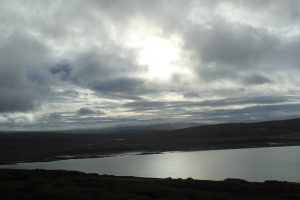
In fact that summed up that morning pretty well – up and down, up and down. At the top of each mountainous area it could get pretty dang cloudy and/or rainy.
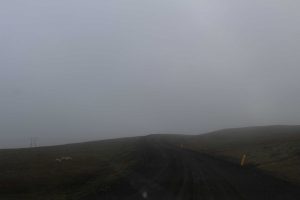
Sheep, always sheep. Everywhere sheep.
This next photo gives you a good idea of what I’m talking about. Here we are getting ready to begin the “down” part of the process.
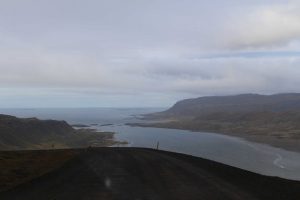
As is obvious this makes for some awesome views. Also some interesting driving, but mostly great views.
I guess there is also an “around” part that I should add to the “up” and “down.” Since really it’s “up-down-around-up-down-around.” It’s not like there are bridges over the vast majority of the fjords, so you have to route around each one. The result: A LOT of driving to get a short geographical distance, but some cool (or hot?) stuff to look at.
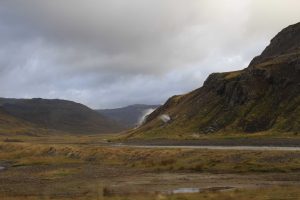
Here’s another good shot of the “around” portion of a fjord.

The larger fjords also have “up and downs” within their respective “up” or “down” portions. I think you get the drift at this point.
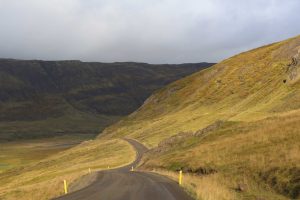
The weather was pretty decent in the “low” areas, it was cloudy and misty but nothing too bad. In fact it added to the ambience.

The weather changed a bit when we shot off on a side road (yep a side road to the side road) to make our way to Rauðisandur (or red sand beach).

It’s hard to capture weather from inside a car, but just trust me that it was nasty. 🙂
The good news is that Rauðisandur was pretty awesome – and massive. You don’t really anticipate how huge it is until you come over a mound and see it below you.
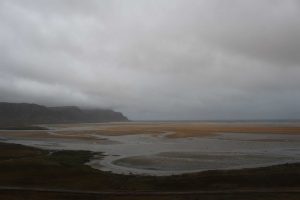
We made our way all the way down to it, which offered up some great coastal views. There is even a little village there that is so small I’m not even sure what the name of it is.

A lot of water (a lot) flows down from the hills, so the road is pretty rough along the coastline. Most of the streams sort of just meander their way along the massive beach and out to the ocean.

Once we were done at Rauðisandur we had to retrace our route back up into the mountains since the coastal road just ends. Once reunited with the “main” (i.e. secondary) road we started making our way towards the western extreme of the Westfjords.
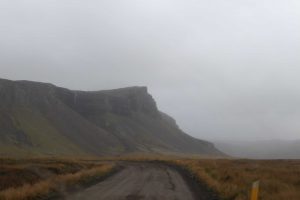
Along the way we saw so many rainbows! Holy cow! While Iceland is known as the “Land of Fire and Ice” I’d posit that the “Land of Rainbows” might be just as accurate, if a little less mythical.
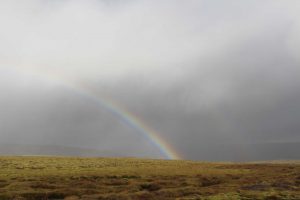
The road through those areas was pretty rough at parts, but when you look at the area it’s easy to understand why.
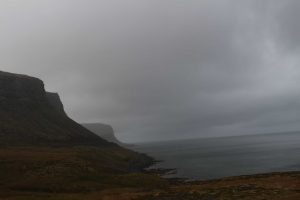
Still, ever resilient, there are a few communities out there. I’m hesitant to call them “towns” as that seems to imply that they have more than they actually do.
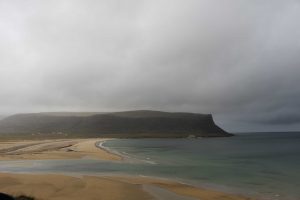
One such area, Hnjótur, even had what I think to be an old Douglas DC-3 from the U.S. Navy. I’d like to know the story behind that one.
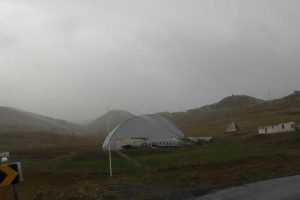
After Hnjótur the road (and weather) got even worse, but Sue trudged on!

While the driving was kinda stressful in a few spots out there due to wind, it was absolutely gorgeous in spite of that.
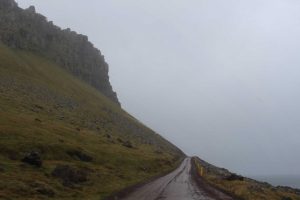
Now, if you’re wondering why we were going way out into the boonies – well, then you probably don’t know us that well. 🙂
However, we did have a goal, Látrabjarg! Látrabjarg is a massive coastal cliff and is the westernmost point in Iceland. It’s also apparently the westernmost point in Europe if you exclude the Azores. Once you’ve finally made your way to the end of the road (literally) there is a small parking area, and then you continue on foot from there.
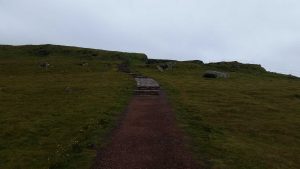
Once on top you get an AMAZING view of the cliffs and ocean. Pigsten Approved.™
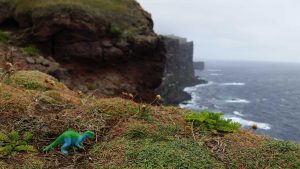
Here’s a slightly pulled-back shot of SB getting some “looking down” photos.
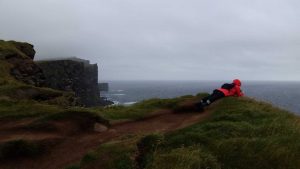
And then here is a wide-angle shot from just a bit further along the cliff-face.

While SB and I were taking pictures (you know, boring human stuff) Pigsten was gathering a couple of Látrabjarg rocks for his collection.
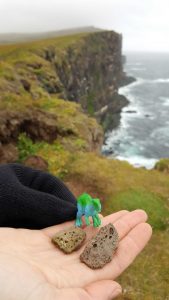
After spending some time at Látrabjarg (including eating lunch in Sue – the wind made it nearly impossible to eat anyplace else) we started making our way back up the fjord.
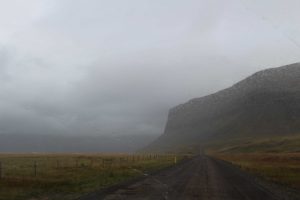
After a bit the rain started to clear up.
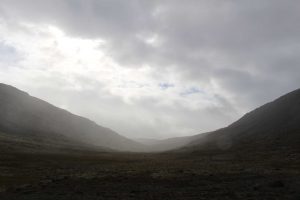
And by the time we’d reached civilization (i.e. those 2 buildings and the truck you see) the sun was even trying to peak out!
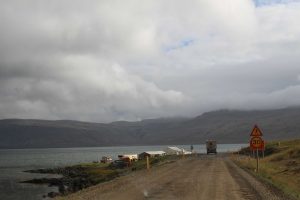
Heck, we even got more spoiled when the road turn backed into a paved road!
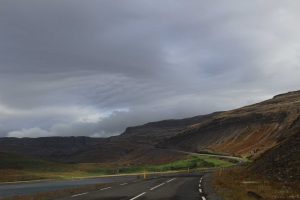
Naturally the sun didn’t last long, but the smooth roads were a welcome site regardless.
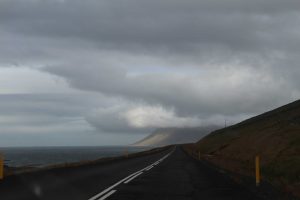
There was one point where the only other “car” we saw for a long, long time was a tractor.
In fact we ran into WAY more sheep traffic than we did car traffic. There were several points in which the sheepie-friends were taking up the entire road and didn’t really seem to care too much about us wanting to get through.

After that valley with the sheep we made our way along the coast for awhile.
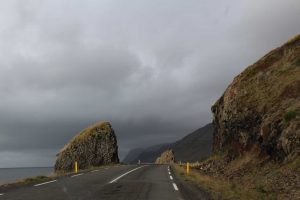
This part of the road gave you a good look at some of the adjacent fjords.
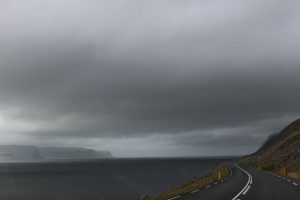
From there we went “up” again which meant that the pavement disappeared as expected, however this time it was like we’d somehow teleported to an alien planet. It was a massive rock landscape with nothing but some kind of occasional fungus. It was basically Pigsten’s heaven.
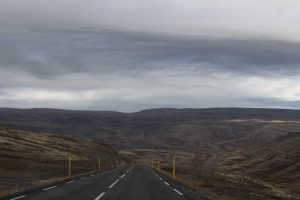
After quite some time in the alien world we started making our way back down toward greener landscapes and also human civilization.
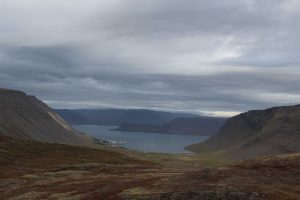
In fact in got quite green there for awhile!
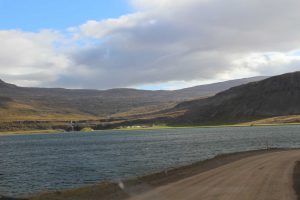
While we obviously weren’t in a desert, this green little oasis was complete with a few houses and a nice waterfall.
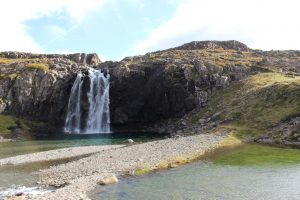
Then, almost as if the whole thing had actually been a mirage – we went straight back up onto Mars.
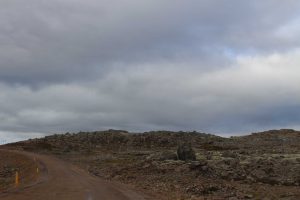
Heck, in keeping with the Mars theme even the road turned red for awhile.
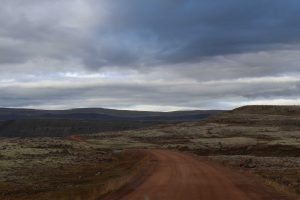
After a lot of Pigsten excitement and a lot of driving we started gradually making our way down and grass started slowly returning to the landscape.
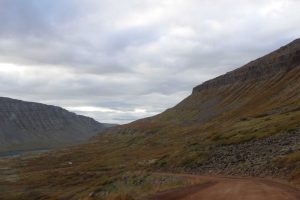
The traffic picked up too, as in, from none to one. I was wondering why but it turned out that we were actually getting close to our next planned stop, Dynjandi!
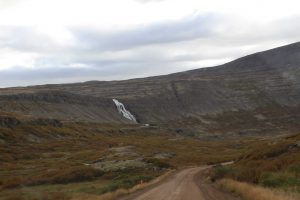
Dynjandi is actually a series of (gorgeous) waterfalls which in total amount to about 100 meters (330 ft) of drop.
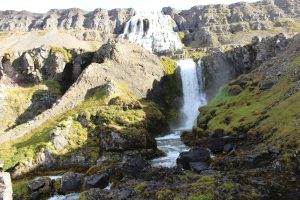
Pigsten thought the waterfalls felt like “dinosaur times.”
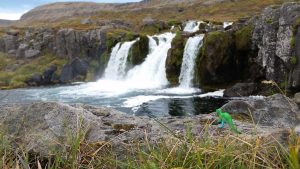
Here is a slightly pulled back shock to give you an idea of the layout – though it gets the scale all wrong.
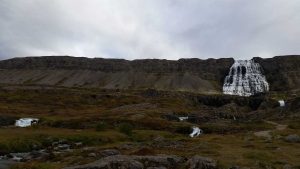
I think Pigsten gives a better frame of reference for size.
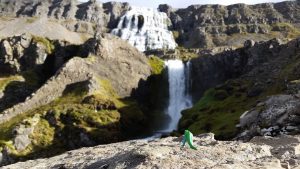
In fact, it’s hard to tell it from still photos, but you have to do a decent jaunt up the mountainside to get to the higher tiers of the waterfalls.
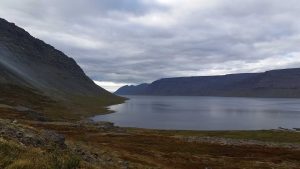
This next photo gives you a better idea of the “tiers” I’m talking about – even though it cuts out most of the lower ones. Also, notice that awesome water-flow pattern in the rock!

Here’s another similar shot, just from a little higher up and a little more to the side.

Then here’s a shot of Pigsten fairly close to the highest (and largest) waterfall. “Fairly close” because we didn’t want Pigsten to go on a magical river adventure.
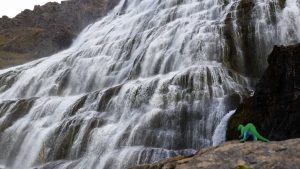
After spending some time at Dynjandi we got back on the road as the sun was getting pretty deep on the horizon. The plus side is that it made for some beautiful driving.
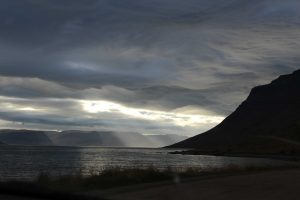
After driving along the coast for awhile we went “up” into muddy roads again, but we were actually pretty close to our destination for the second night – Þingeyri.

Nope those three scattered buildings are not Þingeyri, those are actually the bustling suburbs of Þingeyri. This is Þingeyri.
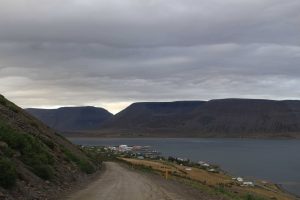
As you can see it’s a decent size, and during the busier months boasts a massive 260 person strong population. More importantly, it has a gas station, always a good thing.
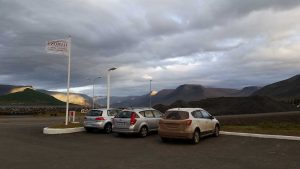
As is obvious from the above photo Sue was in need of some TLC (betcha’ can’t guess which one is Sue!). Fortunately, not only did the gas station serve food (one of only two such places in the whole town still open in mid-September) but it also had a free car wash. Car wash might be a stretch as it was just a high powered hose and nothing else, but it did the trick with some elbow grease and extremely cold hands that didn’t regain feeling for about 10 minutes.
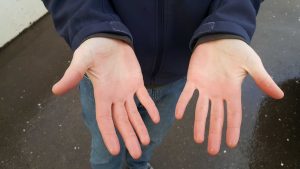
We were staying at the Hótel Sandafell, which is actually more of a guesthouse than a hotel – at least for us, we had a shared bathroom. However, like Hotel Ljósaland, Hótel Sandafell wasn’t exactly bumping. There were at least other people this time, but our shared bathroom turned out to just be shared between SB, the Boys, and I. There are benefits to traveling at the very end of the season! The hotel is right across the street from the fire station, and Tristen really liked the old firetrucks.

That evening we got to bed early after our long day of adventuring. The next morning we had breakfast at the hotel. Breakfast was actually late as the owner.. uh forgot to show up? Not really sure, but someone called and eventually it got sorted it. Turned out to be a really good breakfast too! Plus we had a nice, if not rainy, view of the fjord while we ate.
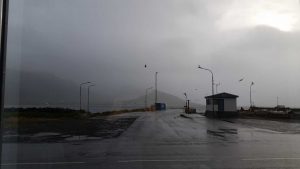
After getting our bellies full the Boys were ready to get back on the road!
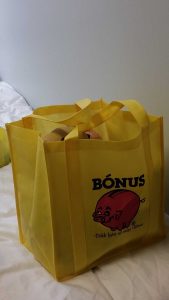
And get back on the road we did – complete with a fresh round of rain.
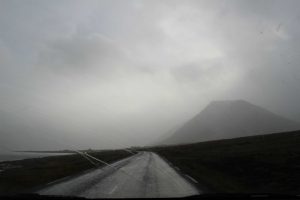
Still, as we made our way around the fjord the sun began to just barely burn its way through the morning mist.
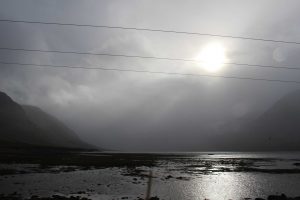
From the coastline we made our way “up” again – except this time something a little different happened. Rather than going up to to the “top” we instead found ourselves facing a tunnel (Pig was pleased)!
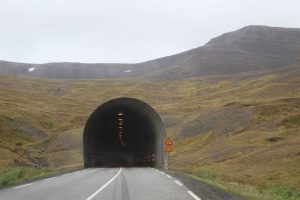
Turns out that this tunnel, Vestfjarðagöng (Vestfirðir Tunnel), was even longer than Hvalfjörður and clocks in at 9,113 m (29,898 ft – 5.66 miles) long! I’ve always found it difficult to take photos of a dark tunnel from a moving vehicle, but SB got some decent ones.
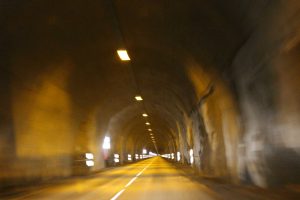
We agreed that it felt like some underground lair from a spy movie. There were multiple routes in there and everything. It was pretty crazy.
Once you exit Vestfjarðagöng (and get re-acclimated to the surface world) you get a view of Ísafjörður, the”capital” of, and largest town in the Westfjords.
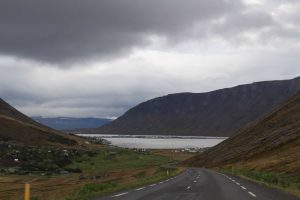
We made our way down into the town (passing a Bónus along the way – as Pig was quick to point out) and parked at the visitor’s center. Turns out it was no longer open on the day we were there – one of the downsides of being late in the season. However we didn’t let that stop us from walking around a bit!
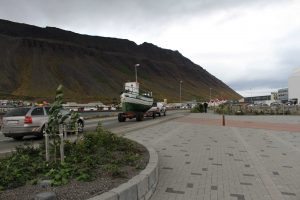
We made our way to the town square, and while most of the stores had closed for the season there were still a few open.
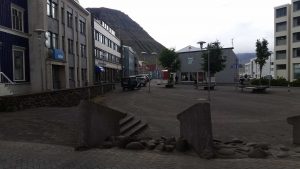
With a population of about 2,600 Ísafjörður was by far the most substantial town we came across during our journey (outside of the capital area, obviously).
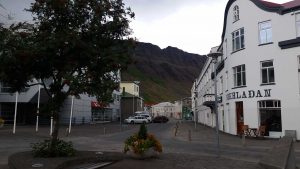
Once we’d walked around “downtown” a bit we made our way to the harbor area.
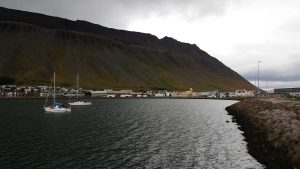
There were quite a few fishing vessels and other kinds of ships in port. The Boys enjoyed that.
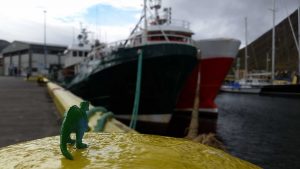
As we crept along the coastline we made our way towards the Westfjords Heritage Museum, which was supposed to be open but like most things in Iceland the schedule is just a possibility, and it was in fact closed.
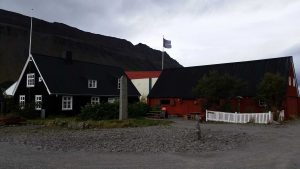
However, there is a restaurant right next to the museum (red building to the right in the above photo) which was open. The restaurant, Tjöruhúsið (fish house) turned out to be one of the most highly recommended places to eat in the entire country. In fact, some reviewers have said that it was the best fish they’d had in their entire lives. Unfortunately SB and I had eaten a large breakfast not that long ago and we were not hungry, a bummer, I know.
That said, despite not really being hungry, we did use Tjöruhúsið to seize a food-related opportunity: the quest for kæstur hákarl. Just what is kæstur hákarl you might ask? Well, it’s a national dish of Iceland, steeped in hundreds (and hundreds more) of years worth of history and is often served with another Icelandic signature, Brennivín (a 75/80 proof clear, unsweetened schnapps).
Oh and kæstur hákarl is also fermented shark meat. Yep, the meat comes from the Greenland Shark (or other sleeper shark), and apparently the meat is poisonous when fresh (always a good sign). However, after several months and a bunch of ammonia (seriously) it becomes “edible.”
In fact, I’m going to share the process for preparing kæstur hákarl, because it’s just that ehm… interesting.
“The traditional [preparation] method is by gutting and beheading a Greenland or sleeper shark and placing it in a shallow hole dug in gravelly sand, with the now cleaned cavity resting on a small mound of sand. The shark is then covered with sand and gravel, and stones are placed on top of the sand in order to press the shark. In this way the fluids are pressed out of the body. The shark ferments in this fashion for 6–12 weeks depending on the season. Following this curing period, the shark is then cut into strips and hung to dry for several months. During this drying period a brown crust will develop, which is removed prior to cutting the shark into small pieces and serving.”
Now, doesn’t THAT sound appetizing? Apparently it did, because SB and I were on the prowl for both kæstur hákarl and Brennivín. And, it just so happened, that Tjöruhúsið was offering both of them. So, despite not being hungry, we decided to just go for it – why not extend our geographic adventure into the culinary front?
Turns out Tjöruhúsið was out of Brennivín, however they did have kæstur hákarl. So, with vodka as a our Brennivín substitute, we prepared to dig in.

Now, I have to say here, if you know me you’ll know I will eat just about anything. On top of that, it’s very rare anymore that I find something I just despise. 99% of the time I will try what is presented (and 1/2 year old rotten shark should confirm this). So, I do not have a picky palate and am mostly on the “see food” diet (I see food and I eat it). Thus, what follows is the impression of someone who is most definitely not a picky eater.
It was ehm, not good. To get a feeling for what it’s like to eat, imagine that you have a piece of chewy fat. This fat has set out for months. You then take that fat and cut it up into little cubes. You then take those little cubes and stick them in a jar of ammonia or a house cleaning chemical of your choosing. You then eat said cube. Delicious.
I’d heard the smell was bad, to me the smell wasn’t really that bad. I mean yeah, it smelled like you were getting ready to eat formaldehyde (and I guess you sort of are) – but it wasn’t gag-inducing. Heck, when you first eat the little cube you get a fishy taste and your brain is like, “Hey this isn’t so bad!” Then about 3 seconds pass and suddenly Lucifer himself arises from the 7th circle of hell in your mouth.
Yes, as you chew something magical happens. That little bit of fish you just bit into suddenly becomes chewy, tough even, and it fills your mouth full of rancid acid piss. I mean, what the hell can you expect for 1/2 year old rotten flesh? But yeah, it’s pretty damn bad. It’s so bad in fact, that the vodka does nothing to get the taste out of your mouth. Indeed, I’d argue that the worst part about kæstur hákarl isn’t the immediate eating. It’s the fact that the taste and smell linger in your mouth for hours after you eat it. It’s like the haunted and tormented soul of Mr. Clean has decided to take up residence in your mouth and decorate the place with 10,000 year old floor cleaner. Despite SB and I’s best efforts to remove the taste with water, soda, and food – we really just had to let time run its course.
Would I eat it again? That’s a solid no. Should you try it? Yes. However you don’t need to go all the way to the boondocks of Iceland to try it. Just got soak a dish sponge in muriatic acid and eat it, same experience.
Once we were done eating the food equivalent of 7 tours in Nam’ I took some time to walk along the beach and ponder whether or not kæstur hákarl would survive the implosion of the sun. My guess is yes. Hopefully when we manage to find Brennivín it won’t be quite as traumatic of an experience.

The environment hid the torment of my ammonia-ridden soul.
Having poisoned ourselves, we decided to head out of Ísafjörður – though we did stop at Pig’s Bónus on the way out! Our next stop was the fishing village of Súðavík. More specifically we were headed to the Arctic Fox Research Center!
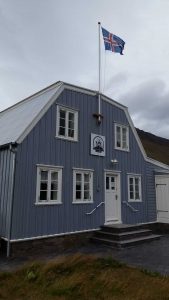
Now, if you’ve read this blog for any amount of time you’ll know that SB and I will go way [way] out of our way to see naminal’ priends. This was no exception. We came to see the ambassador foxes and ended up not only getting to see them, but also a surprisingly good museum for its size as well.
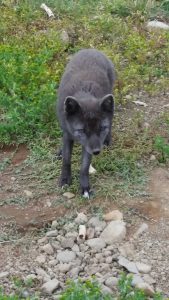
If you were expecting them to be white, don’t be too surprised! They come in three different major color groups (white, brown, and “blue”) as well as variants thereof. Prior to our visit I didn’t really know much about the arctic fox – such as the the fact that it’s Iceland’s only native land mammal, meaning that those 1 trillion sheep are immigrants!
After spending some time with the foxes we got back on the road as SB and I were starting to get hungry (rotten shark notwithstanding).

As this is the highway that leads to Ísafjörður, it’s in good shape. However, it’s basically a long string of “around” the fjords, with a bit of “up” and “down” added in. So it’s somewhat slow going insofar as Point A to Point B goes, but it’s largely a very scenic drive, complete with a cool rock arch to drive through!
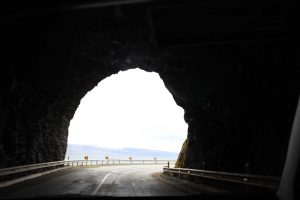
The weather followed a predictable pattern. On the “inlet” side of the fjord it would rain, and then near the “mouth” of the fjord it would be sunny.

Sheep were also a constant. Sometimes they were willing to share the road, other times they seemed quite cranky that you were in their personal space.
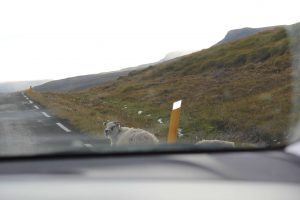
Speaking of sheep, it was right around in there that SB and I came across what we called “The King of Sheepies.”

It’s kind of hard to make out from that photo, but that sheep was HUGE and brown. Thus the King of Sheepies was so dubbed.
After passing the King of Sheepies we were actually getting close to our chosen lunch location. As you can see it’s not like we were really next to any civilization.
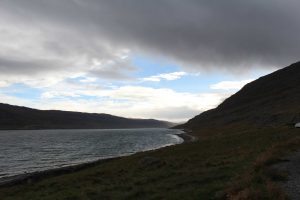
However, way out there, nestled along the coastline of Skötufjörður is Litlibær (Little Farm).
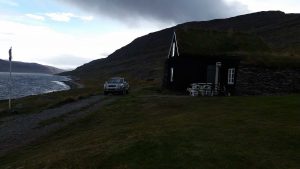
Litlibær – which we mistakenly assumed meant “Little Bear” – is a farmhouse which was built in 1895 and once housed two families consisting of 20 (yes 20) people. Today a lovely older couple lives there and runs a basic cafe out of the home. I say basic because the menu is coffee and waffles, that’s it. In fact, “coffee and waffles” seems to account for about 1/2 of the English they know, but that really didn’t matter because they were super nice, the price was extremely reasonable, and the waffles and coffee were awesome – as was Litlibær itself.
Litlibær isn’t really set up like a traditional cafe, this is part because it’s so small ~29 m² (~311 ft²), but also because it’s still more reminiscent of a farm house than a commercial cafe.
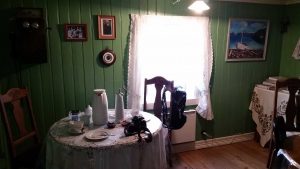
I don’t know how much, if any, of the items in the house were brought in for effect versus had always been on the property, but everything fit in really well.
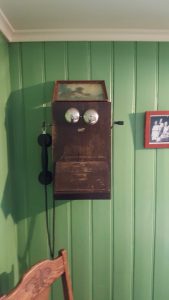
The waffles were also really good, though I guess when the last thing you ate was rotten meat the bar is rather low. However I’d say that even absent the previous dish these waffles were awesome.
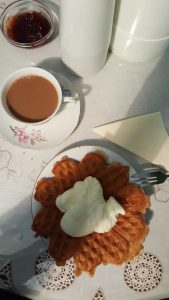
Our table was right next to a window so we were able to take in the view of Skötufjörður while we ate.
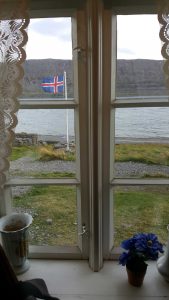
There wasn’t much in the way of traffic, unless you consider sheep traffic. In fact there were quite a few sheep that were wondering around right outside of Litlibær. SB decided to say hello to them, however the “lead sheepie” wasn’t having any of SB.

He’s the one just left of center in this next photo. He did not like SB being on “his” road.
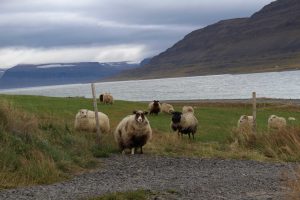
After the lead sheepie had removed SB the flock made their way into Litlibær’s front yard to nom’ the grass there. We then left the sheep to their lunch and hit the road again.
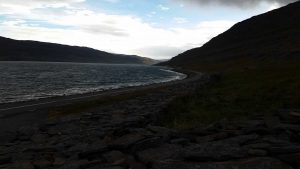
Just a short way down the road from Litlibær there were a load of waterfalls and springs just right next to the highway.
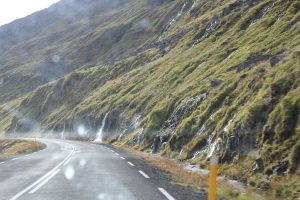
Skötufjörður broke the pattern of inland rain, and we had pretty good views the whole way “around.”
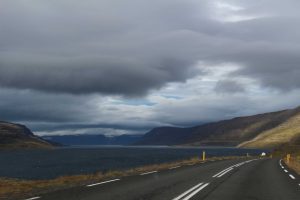
There were a few dotted homes (and ruins) through there.
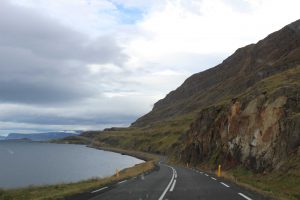
However there were definitely more sheep than people.
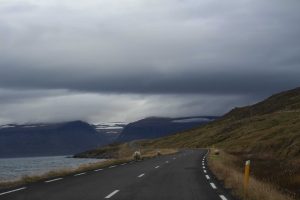
In fact, on the next fjord over – Mjóifjörður (which was massive) – I think there were more rainbows than people!

However, as we made our way inland the rainbows of Mjóifjörður gave way to lots of rain and fog.
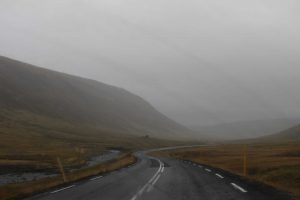
That’s pretty much how it continued until we made our way to our destination for the third night, Hólmavík – a town of ~375 nestled along Steingrímsfjörður. However, we weren’t really staying in Hólmavík but instead we were staying in a bonafide farmhouse outside of town.
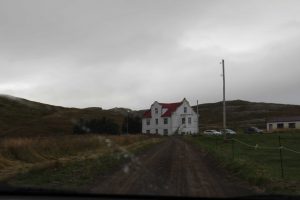
The farmhouse, known as Víðidalsá, has a few rooms that the owners (and their dog Lopa!) rent out – but make no mistake, this is an old farmhouse, not a hotel! That’s actually a big reason SB and I picked it, since how often do you get to say that you stayed at Víðidalsá in Vestfirðir!
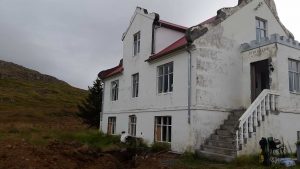
Despite the seeming remoteness of Víðidalsá it’s really not that far from Hólmavík – you can see the town in the distance in the photograph below.
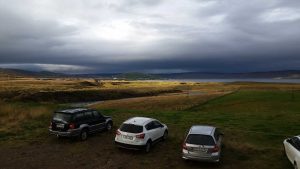
However one could get into the semantics of whether or not Hólmavík counts as non-remote or not. 🙂
After chatting with the owner for a bit, SB and I headed into town.

Aside from Víðidalsá and the geographic convenience of Hólmavík, a big reason we had came this way was Strandagaldur (The Museum of Icelandic Sorcery and Witchcraft).
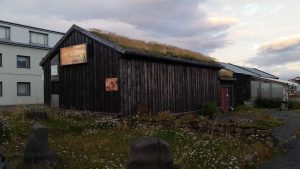
This small museum has quite a good reputation and it was also highly recommended by the owner of Víðidalsá as well. If you know me, you’ll know that I have slightly more than a passing knowledge of witchcraft and that it’s a topic of great interest to me. As such, I jumped at the opportunity to go to a museum all about that topic – especially in an topical area where I knew very little.
The museum itself was really interesting. The downstairs portion focuses a lot of specific spells, hexes, etc. and gives historical accounts of them being used – and, in some cases, the resulting bit of being burnt alive (you know, a minor detail that). The “necropants” (Nábrók) are of special note (yes I’m being serious). The downstairs had a bit of a comical tone, but overall it was mostly serious and was really approachable unless you don’t like reading more than 2 sentences. The upstairs was more focused on the genealogy of the people/clans involved, as well as in primary source documents and materials (grimoires, etc.). It was a bit more “museum-like” but equally enjoyable for me.
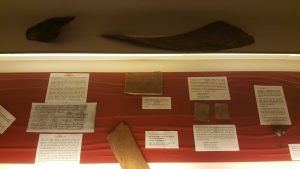
One neat piece on display was a stone which came from Goðdalur (dale of the gods), a remote valley in Bjarnarfjörður.
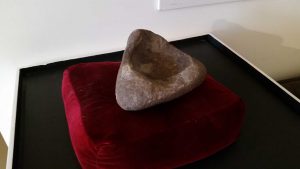
This stone is believe to have been a ritualistic blót (sacrifice) stone. There’s a good deal of historicity surrounding the stone, but the most noteworthy bit is that legitimate forensics testing has confirmed that there is blood residue within the pit of the stone. I’ll let your imagination do the rest. 🙂
After learning a lot about witchcraft in Iceland we had worked up an appetite. The good news is that the museum just so happens to have a place to eat – Restaurant Galdur – as well! If you’re anticipating that this is one of those “leaves a lot to be desired” food places that some museums, etc. have then you’ll be surprised. SB and I didn’t really know what to expect other than that it was a predominantly lamb and seafood based menu (e.g. most of Iceland). However, turns out the food was extremely good. SB went for the lamb steak whereas I had the seafood soup. Both were awesome.
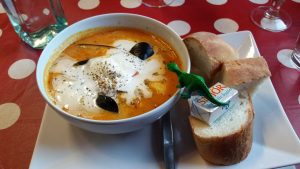
After a yummy dinner and a couple of beers we made our way back out to the farmstead just as the sun was going down.
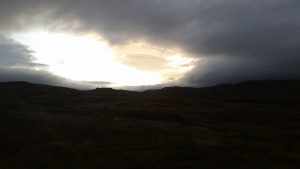
That night we pretty much just chilled in our room and looked through some of the photos we’d taken that day and the day before. Eventually everyone else was asleep, except for Lopa!
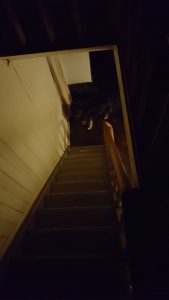
Believe it or not she can make her way up and down those steep farmhouse stairs like a pro!
It was really nice how quiet it was out there. Really the only noise you could hear was those noises which infallibly come from old farmhouses, various creeks and groans and the like. I slept really well, though at one point when I woke up I noticed that light was coming through the edges of our door. Gotta love old houses.
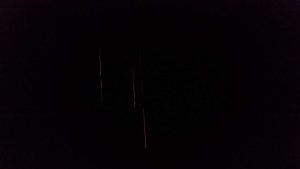
The next morning we awoke to the sun peaking in through the curtains.
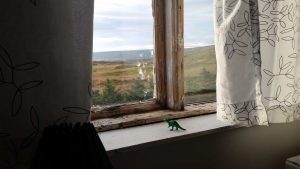
Pigsten used the opportunity to take in some Vitamin D – dinosaurs need their sunlight after all!
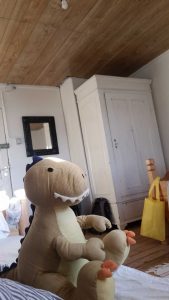
As we were getting around Tristen attempted to find Narnia inside of the wardrobe.
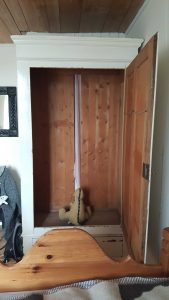
After that we headed downstairs for some conversation, coffee, and freshly picked blueberries!
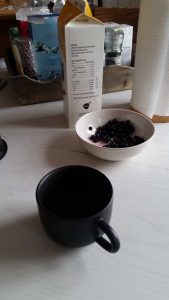
We then went about getting cleaned up in the bathroom, which oddly enough looks like it froze in time in the in both the 1920s and 1960s.
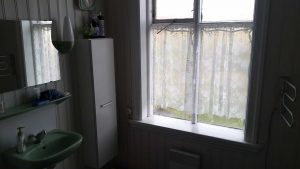
Then we said goodbye to our comfy old beds and were back on the road again.
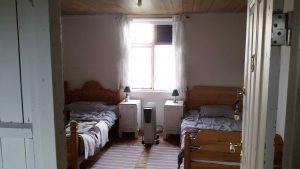
Lopa even followed us to say goodbye!
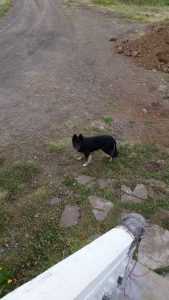
From there we started making our way back down the way we came.
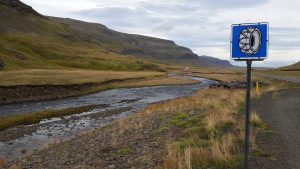
We did have one bit where our gas got pretty low due to a miscalculation on distance, but fortunately Sue didn’t starve – plus the place where we stopped for gas had a restaurant that was yummy, despite being fairly isolated.
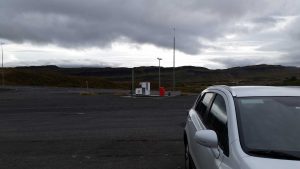
Once we were on our way again we saw a bunch of horses along the coast.
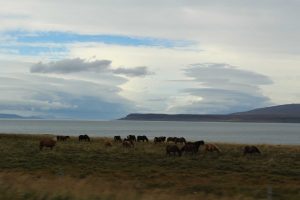
We then stayed on the same route until got back to the Hvalfjörður Tunnel. This time we opted to save the 1000 ISK and go around Hvalfjörður rather than under it. This turned out to be a good idea not only due to cost, but also because of the scenery you miss if you just take the tunnel.
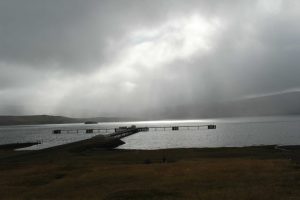
We drove in and out of a few rain showers along the way, but it was a very pleasant drive.
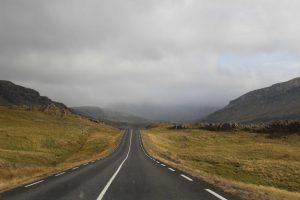
Hvalfjörður followed the pattern of being rainy on the inner portion, but here is a nice shot of the coastline between rain showers.
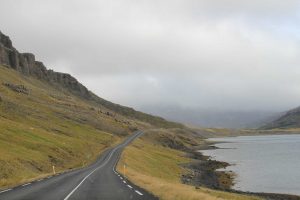
As we made our way around the fjord the sun came out a little bit and gave us a good view of our surroundings. Here you can see the fjord itself, as well as the area we’d come from. Hvalfjörður Tunnel is somewhere beneath the water!
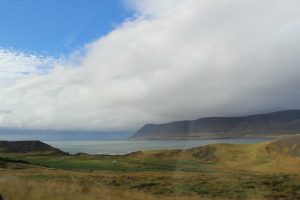
It was a worthwhile sidetrack, we got to see a lot of pretty landscape, a few little villages, some ruins, and even a few little waterfalls! Definitely worth it, even if it took way longer than the tunnel.
After that it was just two more “arounds” and then we were back in the Reykjavík area. We utilized Sue to do some shopping at Krónan, a nice opportunity since we don’t normally have access to a car and instead have to carry all our groceries. After that we made our way back home and then I took Sue back to his house (thanks for the trip Sue!).
Since it was Sunday we then spent the rest of the evening getting settled from our trip and preparing for the week ahead. Such is life after a mini-vacation!
All in all it was a great trip. Icelanders had told us that we probably shouldn’t do it in winter, and I definitely know why based on the condition of the some of the roads in September. We all really enjoyed it, and while having more time is always nice, I feel like we did a pretty good job of seeing as much of the Westfjords as possible within our limited schedule. I’m also really glad that we decided to the Westfjords as their own trip as opposed to trying to tack them onto another trip. They are fairly out of the way – all in all we drove Sue 1247.5 km (775.2 miles) – but it was definitely worth it!
I hope you enjoyed “riding along” with SB and I on our first trip outside of Reykjavík!
This post concludes my “Iceland Introduction” six-post series that I wrote in a big flurry of blogging. In a forthcoming and yet-to-be-written post I’ll probably write about some more mundane topics like school and just adjusting to life in a new country!
Until next time,
-Taco
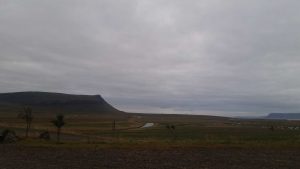
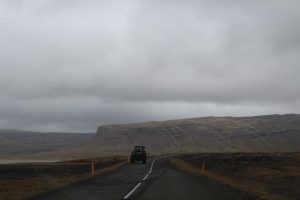
What beautiful pictures! I am so glad that you all got to have this opportunity.
The wiki page for the death pants literally made me lol.
The necro pants were definitely very interesting. Not what I expected to see when I walked into the first room. 🙂
Well Im just envious…. Thats all I got to say about that
AWESOME !!!
Your photos are absolutely breathtaking! Like your dad, I am jealous.
Your fermented shark tale made me burst out laughing– I think I will NEVER try it and just take your word for it. LOL
In the picture of Pingeyri– did you notice the large green things out in the water– did anyone mention what those are? In Japan I saw something similar off the coast and they were growing something off of them. I wonder what they represent in Iceland?
The things near Þingeyri are fish farms, more specifically they are pins for selective breeding. I noticed a lot of the villages had aquaculture of some sort!
As for the shark, I consider it my civic duty to warn others. 🙂
Reading your posts, usually a good little while after the trip happened, always gives me such an appreciation for the travel we do. Like it’s a little reminder of the amazingness we got to see and experience.
Side note: I still think it’s crazy that we never paid for breakfast and beers at our first hotel. They weren’t around that morning and never called me, even with the note I left.
We call that good karma, SB! xoxo